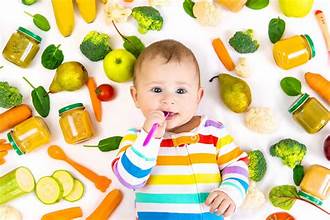What a child needs in his/her first days?
Children need the right foods at the right time to reach their full potential. The most critical window is the first 1,000 days from pregnancy until a child’s second birthday.
Breastfeeding during the first two years is life-saving. It protects against disease, supports brain development, and provides safe, nutritious food.
At six months, children require nutrient-rich complementary foods alongside breast milk. Meals should be frequent, varied, and prepared safely, with caregivers responding to hunger cues.
However, many children do not receive the nutrition they need. Less than half are breastfed within the first hour of life, and only 60% are exclusively breastfed for six months. Globally, one in three children aged 6–23 months lacks a diverse diet, often consuming mostly grains with little protein, fruits, or vegetables, while sugary and processed foods are on the rise.
Poor diets in early childhood lead to nutrient deficiencies, such as vitamin A deficiency, which weakens immunity, increases the risk of blindness, and heightens vulnerability to diseases like diarrhea.
Ensuring access to safe, affordable, and age-appropriate foods remains a major challenge, especially in crises and humanitarian emergencies.
Nutrition in the First Year of child:
First 12 months are very important period for a child growth and development. Here is the basic nutrition a child need in his/her first period of life.
- Breastfeeding:
- Breast milk is considered the gold standard for infant nutrition. It contains the perfect blend of proteins, fats, vitamins, and antibodies that strengthen immunity and promote optimal growth.
- The World Health Organization (WHO) recommends exclusive breastfeeding for the first six months of life.
- Infant Formula:
- For parents who cannot or choose not to breastfeed, iron-fortified infant formula is a safe and healthy alternative.
- Pediatricians often guide parents in choosing the right formula, especially if an infant has allergies or digestion issues.
- Introducing Solid Foods:
- Around six months, infants are developmentally ready to begin complementary feeding.
- Iron-rich foods such as fortified cereals, pureed meats, and legumes are excellent first choices.
Importance of breastfeeding:
Breastfeeding is good for both you and your baby. Breast milk is the best source of nutrition for most babies. As your baby grows, your breast milk will change to meet their nutritional needs. Breastfeeding can also help protect you and your baby against some short- and long-term illnesses and diseases.
Complementary Feeding:
Complementary feeding refers to the gradual introduction of solid foods and drinks alongside breast milk or infant formula to meet a growing child’s increasing nutritional needs. Around 6 months of age, babies need more energy, protein, and micronutrients than milk alone can provide, making this transition a vital step in healthy development.
During the first and second years of life, children slowly learn the skills needed to join family mealtimes. By the age of 2, most children can eat a wide variety of foods prepared for the rest of the household. This period also marks important milestones such as self-feeding with fingers, sipping from a cup, and beginning to use a spoon with guidance.
Offering a range of textures, colors, and flavors not only provides essential nutrients but also helps expand a child’s taste preferences and reduces the chances of picky eating later. Caregivers should focus on safe food preparation, regular mealtimes, and patience, since it may take multiple exposures before a child accepts new foods.
Establishing healthy complementary feeding practices early on ensures proper growth, strengthens immunity, and lays the foundation for lifelong healthy eating habits.
Toddler Nutrition from 1–3 Years:
As a child is growing and developing its life stage they need more nutritious food for better development and for performing supportive activities.
As babies grow into toddlers, their nutritional needs shift to support increased activity and continued development.
- Balanced Diet:
- Toddlers require a variety of foods from all food groups like fruits, vegetables, grains, proteins, and dairy.
- Small, frequent meals are often better suited to their smaller stomach capacity and variable appetites.
- Developing Healthy Eating Habits:
- This stage is critical for establishing lifelong dietary preferences.
- Encouraging self-feeding, offering a variety of textures, and modeling healthy eating behaviors can reduce picky eating.
- Limiting Sugary and Processed Foods:
- Excess sugar and sodium can increase the risk of obesity and heart disease later in life.
- Parents should focus on natural, nutrient-dense foods instead.
Helpful Tips for Introducing Solid Foods:
- Start at the right time: Most babies are ready to try solid foods around six months of age.
- Pick a first food: Whether it’s infant cereal, pureed fruits, vegetables, beans, or soft meats, any nutritious option can be your baby’s first taste.
- Prioritize iron-rich foods: Offer foods like fortified cereals, lentils, meats, or beans at least twice daily to meet growing iron needs.
- Go beyond rice cereal: for iron-fortified oatmeal, barley, or mixed-grain cereals for more variety.
- Watch out for choking risks: Always prepare age-appropriate textures, and consider taking an infant CPR class for confidence and safety.
- Use a mix of feeding styles: Combine spoon-feeding with safe finger foods to encourage independence and skill-building.
- Expect gagging at first: Gagging is a normal part of learning to eat solids and usually not a sign of choking. Stay calm and supportive.
- Introduce common allergens early: Foods like peanuts, eggs, dairy, soy, and fish can be introduced around six months, unless advised otherwise by a pediatrician.
- Respect your baby’s appetite: Offer food, but let your baby decide how much to eat. Avoid pressuring or force-feeding.
- Practice cup drinking: Around six months, let your baby try small sips of water from a cup. It may be messy at first, but it builds important skills.
What to Offer as Baby’s First Foods?
In the past, iron-fortified single-grain cereals mixed with breast milk or formula were considered the standard first food for babies. While they are still a good choice, they’re no longer the only option. What matters most is prioritizing iron-rich foods when starting solids. By around six months, a baby’s natural iron reserves begin to run low, so getting this nutrient from food is essential for healthy growth and development.
Age 6 to 7 Months Iron and Protein Sources:
- Meat and poultry: Cooked until soft, then puréed, finely minced, shredded, or shaped into small patties or meatballs.
- Low-mercury fish: Thoroughly deboned, cooked, and served as a purée or in soft, flaked pieces.
- Eggs: Served in different textures—mashed hard-boiled eggs, strips of omelet, or soft scrambled eggs.
- Beans, lentils, chickpeas: Fully cooked, then mashed or blended into a smooth purée.
- Cheese: Offered in thin slices or finely grated for easy handling.
- Yogurt: Plain, unsweetened yogurt (regular or Greek) as a creamy, protein-rich option.
Conclusion:
The first two years of life represent a critical window for shaping a child’s lifelong health. From exclusive breastfeeding in the early months to the careful introduction of iron-rich complementary foods and balanced toddler meals, every stage of nutrition plays a vital role in growth, brain development, and immunity. Establishing healthy eating habits early—through variety, safe preparation, and responsive feeding—helps children build resilience against disease and fosters positive lifelong food preferences. By ensuring infants and toddlers receive safe, nutritious, and age-appropriate foods, caregivers lay the foundation for stronger bodies, sharper minds, and healthier futures.







